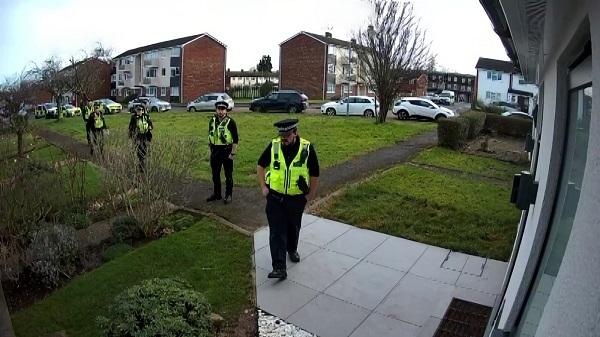Censorship Industrial Complex
Politicians Urge Social Media Platforms to “Quickly and Decisively” Censor Hurricane “Misinformation”

News release from Reclaim The Net
Despite recent pushback for politicians encouraging social media platforms to increase censorship online, in the wake of Hurricanes Helene and Milton, a cadre of Democratic House representatives from the affected regions have appealed to major social media platforms to intensify their efforts to censor alleged “misinformation” related to the storms.
We obtained a copy of the letter for you here.
“We write to your platforms with an urgent request on behalf of states affected by the devastation of Hurricane Helene and those currently being impacted by Hurricane Milton,” the letter states. “In the aftermath of Helene, we have witnessed a troubling surge in misinformation, disinformation, conspiracy theories, and scams that are hindering recovery efforts and exploiting vulnerable individuals and families.”
The representatives say are concerned about the proliferation of false claims and blame these reportedly false claims for the hindering of recovery efforts. The congresswomen also say that social media posts are undermining public confidence in institutions.
The call for a crackdown on misinformation was articulated in a letter addressed to seven major social media entities, including Meta, X, TikTok, Discord, YouTube, Snap, and Instagram. Authored by Representatives Deborah Ross (D-N.C.), Kathy Castor (D-Fla.), Nikema Williams (D-Ga.), and Wiley Nickel (D-N.C.), the letter alleges that misinformation is having a dire impact.
The letter doesn’t directly demand censorship of alleged misinformation, but it does put pressure on platforms to police speech, saying that they have the “power and the responsibility” to “improve the digital spaces.”
The congresswomen say that they “strongly encourage” platforms to act “quickly and decisively.”
In a press conference today, President Biden dismissed some of the criticism of the response to the hurricane as “lies” and said, “Those who have been spreading these lies to try to undermine the opposition, they are going to pay a price for it.”
The political pressure on social media platforms to step in regarding a major event echoes what happened during the Covid pandemic.
During the pandemic, the call for online censorship by politicians and health authorities under the guise of combating misinformation became a contentious issue. This initiative, aimed at preventing the spread of allegedly harmful or misleading information about the virus, its transmission, and treatments, led to a wide array of interventions by social media platforms and tech companies.
As part of these efforts, platforms like Facebook, Twitter, and YouTube introduced policies to flag, remove, or demote content that contradicted the evolving understanding of health authorities such as the World Health Organization (WHO) and the Centers for Disease Control and Prevention (CDC). The intent was supposedly to protect public health; however, the execution of these policies often resulted in the suppression of legitimate discourse and the removal of content that later proved to be accurate.
Censorship Industrial Complex
Welcome to Britain, Where Critical WhatsApp Messages Are a Police Matter

By
“It was just unfathomable to me that things had escalated to this degree,”
“We’d never used abusive or threatening language, even in private.”
|
You’d think that in Britain, the worst thing that could happen to you after sending a few critical WhatsApp messages would be a passive-aggressive reply or, at most, a snooty whisper campaign. What you probably wouldn’t expect is to have six police officers show up on your doorstep like they’re hunting down a cartel. But that’s precisely what happened to Maxie Allen and Rosalind Levine — two parents whose great offense was asking some mildly inconvenient questions about how their daughter’s school planned to replace its retiring principal.
This is not an episode of Black Mirror. This is Borehamwood, Hertfordshire, 2025. And the parents in question—Maxie Allen, a Times Radio producer, and Rosalind Levine, 46, a mother of two—had the gall to inquire, via WhatsApp no less, whether Cowley Hill Primary School was being entirely above board in appointing a new principal.
What happened next should make everyone in Britain pause and consider just how overreaching their government has become. Because in the time it takes to send a meme about the school’s bake sale, you too could be staring down the barrel of a “malicious communications” charge.
The trouble started in May, shortly after the school’s principal retired. Instead of the usual round of polite emails, clumsy PowerPoints, and dreary Q&A sessions, there was… silence. Maxie Allen, who had once served as a school governor—so presumably knows his way around a budget meeting—asked the unthinkable: when was the recruitment process going to be opened up?
A fair question, right? Not in Borehamwood, apparently. The school responded not with answers, but with a sort of preemptive nuclear strike.
Jackie Spriggs, the chair of governors, issued a public warning about “inflammatory and defamatory” social media posts and hinted at disciplinary action for those who dared to cause “disharmony.” One imagines this word being uttered in the tone of a Bond villain stroking a white cat.
|
 |
Parents Allen and Levine were questioned by police over their WhatsApp messages. |
|
For the crime of “casting aspersions,” Allen and Levine were promptly banned from the school premises. That meant no parents’ evening, no Christmas concert, no chance to speak face-to-face about the specific needs of their daughter Sascha, who—just to add to the bleakness of it all—has epilepsy and is registered disabled.
So what do you do when the school shuts its doors in your face? You send emails. Lots of them. You try to get answers. And if that fails, you might—just might—vent a little on WhatsApp.
But apparently, that was enough to earn the label of harassers. Not in the figurative, overly sensitive, “Karen’s upset again” sense. No, this was the actual, legal, possibly-prison kind of harassment.
Then came January 29. Rosalind was at home sorting toys for charity—presumably a heinous act in today’s climate—when she opened the door to what can only be described as a low-budget reboot of Line of Duty. Six officers. Two cars. A van. All to arrest two middle-aged parents whose biggest vice appears to be stubborn curiosity.
“I saw six police officers standing there,” she said. “My first thought was that Sascha was dead.”
Instead, it was the prelude to an 11-hour ordeal in a police cell. Eleven hours. That’s enough time to commit actual crimes, be tried, be sentenced, and still get home in time for MasterChef.
Allen called the experience “dystopian,” and, for once, the word isn’t hyperbole. “It was just unfathomable to me that things had escalated to this degree,” he said. “We’d never used abusive or threatening language, even in private.”
Worse still, they were never even told which communications were being investigated. It’s like being detained by police for “vibes.”
One of the many delightful ironies here is that the school accused them of causing a “nuisance on school property,” despite the fact that neither of them had set foot on said property in six months.
Now, in the school’s defense—such as it is—they claim they went to the police because the sheer volume of correspondence and social media posts had become “upsetting.” Which raises an important question: when did being “upsetting” become a police matter?
What we’re witnessing is not a breakdown in communication, but a full-blown bureaucratic tantrum. Instead of engaging with concerned parents, Cowley Hill’s leadership took the nuclear option: drag them out in cuffs and let the police deal with it.
Hertfordshire Constabulary, apparently mistaking Borehamwood for Basra, decided this was a perfectly normal use of resources. “The number of officers was necessary,” said a spokesman, “to secure electronic devices and care for children at the address.”
Right. Nothing says “childcare” like watching your mom get led away in handcuffs while your toddler hides in the corner, traumatized.
After five weeks—five weeks of real police time, in a country where burglaries are basically a form of inheritance transfer—the whole thing was quietly dropped. Insufficient evidence. No charges. Not even a slap on the wrist.
So here we are. A story about a couple who dared to question how a public school was run, and ended up locked in a cell, banned from the school play, and smeared with criminal accusations for trying to advocate for their disabled child.
This is Britain in 2025. A place where public institutions behave like paranoid cults and the police are deployed like private security firms for anyone with a bruised ego. All while the rest of the population is left wondering how many other WhatsApp groups are one message away from a dawn raid.
Because if this is what happens when you ask a few inconvenient questions, what’s next? Fingerprinting people for liking the wrong Facebook post? Tactical units sent in for sarcastic TripAdvisor reviews?
It’s a warning. Ask the wrong question, speak out of turn, and you too may get a visit from half the local police force.
|
|
|
|
Reclaim The Net values your free speech and privacy. Each issue we publish is a commitment to defend these critical rights, providing insights and actionable information to protect and promote liberty in the digital age.
Despite our wide readership, less than 0.2% of our readers contribute financially. With your support, we can do more than just continue; we can amplify voices that are often suppressed and spread the word about the urgent issues of censorship and surveillance. Consider making a modest donation — just $5, or whatever amount you can afford. Your contribution will empower us to reach more people, educate them about these pressing issues, and engage them in our collective cause. Thank you for considering a contribution. Each donation not only supports our operations but also strengthens our efforts to challenge injustices and advocate for those who cannot speak out. Thank you.
|
Censorship Industrial Complex
They knew it was a lab leak all along

 MxM News
MxM News
Newly Revealed Documents Confirm Lab Leak Coverup
Quick Hit:
The global debate over COVID-19’s origins has taken a dramatic turn after newly uncovered reports indicate that intelligence agencies in Germany had determined with near certainty that the virus originated in a Chinese lab as early as 2020. Despite this revelation, German Chancellor Angela Merkel reportedly chose to suppress the findings, aligning with a broader pattern of obfuscation by Western governments and media outlets.
Key Details:
-
German newspapers Zeit and Süddeutsche Zeitung reported that Germany’s intelligence agency, the BND, concluded in early 2020 with 80% to 95% certainty that COVID-19 leaked from a lab in Wuhan, China.
-
The intelligence was based on a combination of public-domain research and classified investigations under the code name “Saaremaa.”
-
Merkel’s administration allegedly buried the findings, with her successor Olaf Scholz continuing the suppression, ensuring the information remained hidden from the public until now.
Diving Deeper:
Journalist Alex Berenson detailed the shocking revelations in his Substack op-ed, underscoring how “the American media is doing its best to ignore the biggest news this week.” Berenson criticized legacy media outlets for fixating on the five-year anniversary of COVID-19 while sidestepping the implications of newly surfaced intelligence.
According to Berenson, German intelligence reached its high-confidence conclusion after analyzing public materials and conducting covert operations. “The material… indicated that there had been some risky research methods used there [at the Wuhan Institute of Virology], compounded by breaches of laboratory safety rules… [and] so-called gain-of-function experiments, in which viruses occurring in nature are manipulated [to become more dangerous or transmissible],” he wrote.
Rather than alert the world to the evidence, Merkel chose to suppress it. Berenson sarcastically noted, “Who immediately told the world of the findings and demanded a full investigation into what China’s totalitarian government knew and when it knew it? Nah, I’m funning you. Angela stuffed that report in a drawer and got back to doing what she did best, destroying Germany’s industrial base to make Greta Thunberg happy.”
The refusal to disclose this intelligence aligns with a broader pattern of deception from both governmental and media institutions, which spent years dismissing the lab leak hypothesis as a conspiracy theory. Berenson noted that during early 2020, “Dr. Anthony S. Fauci and Peter Daszak… were gently steering their fellow scientists towards a conclusion that COVID’s origins were 100 billion zillion percent natural.”
Even after Merkel left office in 2021, Scholz’s government continued to keep the intelligence under wraps. “The BND told her replacement, Olaf Scholz, ‘without the results finding their way to the public’ — as the British newspaper The Telegraph delicately put it,” Berenson wrote. Now that the findings have emerged, the German government has not denied the reports, leaving Berenson to conclude, “There’s about a 100 to 100 percent chance they’re true.”
The final takeaway? “We all sorta knew this already, right? Both the lab leak and the coverup,” Berenson observed. “But there’s knowing and there’s knowing. And it looks like the same American news outlets that spent 2020 and 2021 lying (or, at best, being hopelessly credulous) about China and COVID still aren’t ready to come clean.”
As new evidence continues to surface, the question remains: Will legacy media and world leaders finally acknowledge the lab leak theory as fact, or will they continue to deflect responsibility and protect their preferred narratives?
-

 Business2 days ago
Business2 days ago28 energy leaders call for eliminating ALL energy subsidies—even ones they benefit from
-

 2025 Federal Election2 days ago
2025 Federal Election2 days agoCarney’s Cap on Alberta Energy Costing Canada Billions
-

 Business2 days ago
Business2 days agoTrump Tariffs are not going away. Canada needs to adapt or face the consequences
-

 Economy1 day ago
Economy1 day agoSupport For National Pipelines And LNG Projects Gain Momentum, Even In Quebec
-

 Health1 day ago
Health1 day agoDr. Pierre Kory Exposes the Truth About the Texas ‘Measles Death’ Hoax
-

 Business14 hours ago
Business14 hours agoDOGE discovered $330M in Small Business loans awarded to children under 11
-

 Business1 day ago
Business1 day agoWhy a domestic economy upgrade trumps diversification
-

 COVID-1912 hours ago
COVID-1912 hours ago17-year-old died after taking COVID shot, but Ontario judge denies his family’s liability claim


